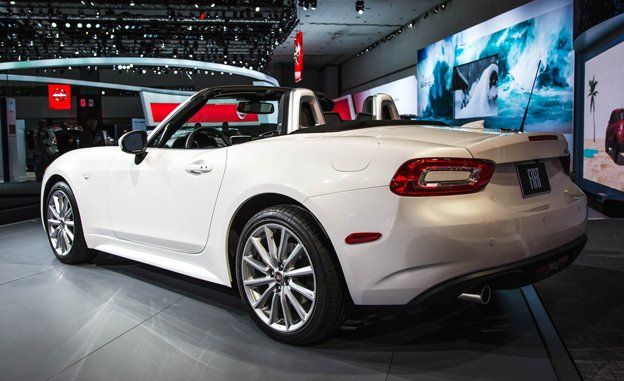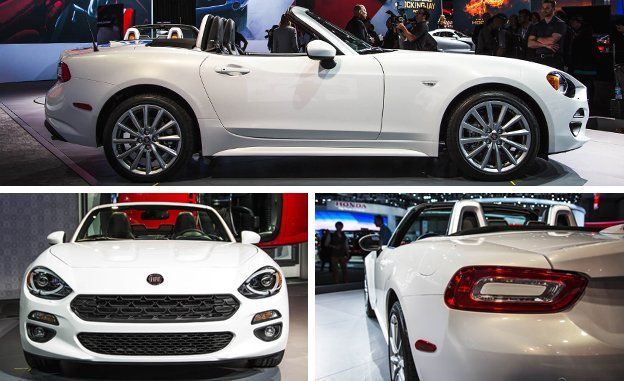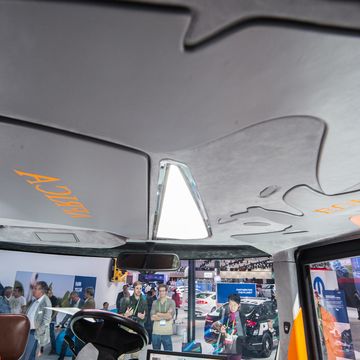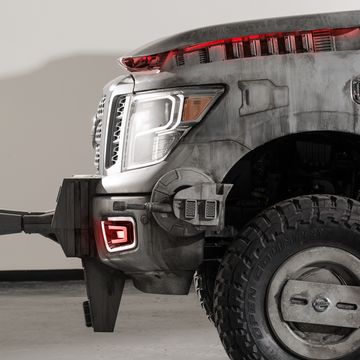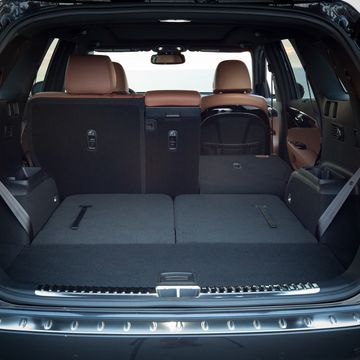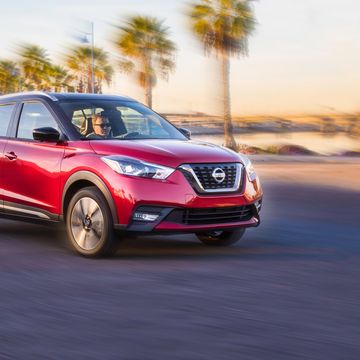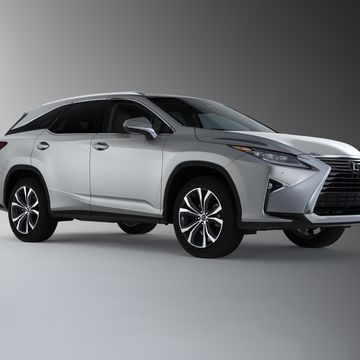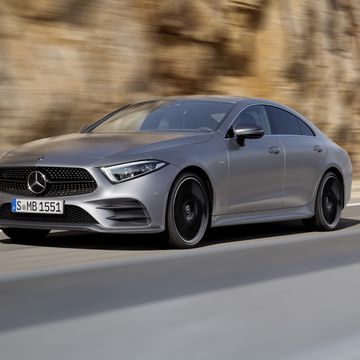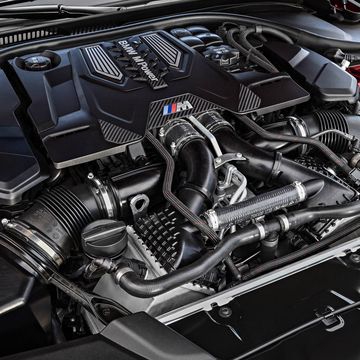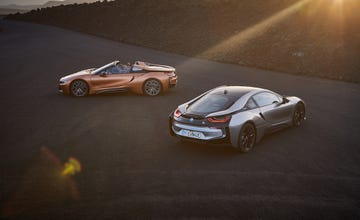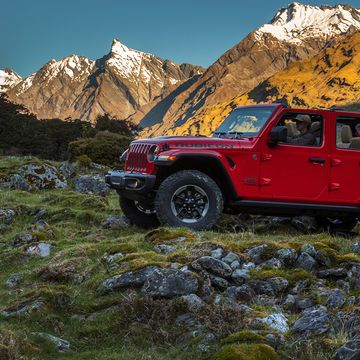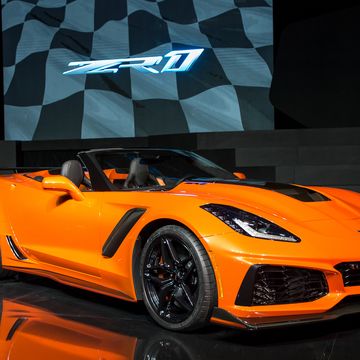When Mazda debuted the surprisingly lightweight fourth-generation MX-5 Miata, it detailed an obsessive campaign to cut needless mass in the tiny sports car. We won’t go into all of those measures here but for one of our favorites: the 2016 Miata’s pared-back, clipped corners. Essentially, Mazda lopped the corners off of the car because corners are useless and detract from featherweight roadster zen. Looking at Fiat’s all-new and Miata-based 124 Spider, it would appear as though the Italians didn’t much care for saving a few pounds and added back the Miata’s corners and then some in the name of—what else?—style.
Underneath, the 2017 Fiat 124 Spider is a new Miata. In fact, the car was even developed for Fiat by Mazda. Yet the Fiat version is appreciably differentiated, at least externally and more so than we originally assumed, and it clearly aims for a richer clientele than Mazda’s hard-core roadster.
Pretty for Pretty’s Sake
Where the Mazda is all sexy curves, sharp Japanese detailing, and functional touches, the Fiat is, well, classically Italian. Those corners Mazda sacrificed on the altar of light weight are yanked out and squared-off front and rear, taffy-pulled into a modern interpretation of the original Fiat Spider’s natty design. The body sides are traditionally rendered, even upright, and punctuated only by a single horizontal character line spanning the front fenders and taillights with but a single Coke-bottle pinch at the trailing edge of each door. Even the mostly round headlights are scooped out of the front fenders and fared in, just like the peepers on the original Spider. At first glance, the taillights resemble those on Maserati’s latest products; study the old 124, however, and the units’ canted, pinched shapes will have you thinking Fiat once more.
Dimensionally, while the Fiat and the Mazda share a 90.9-inch wheelbase, the former is 5.5 inches longer overall. That figure may seem minor, but on the 124, it makes for substantially different proportions, with a longer and flatter rear and a more upright grille situated farther from the windshield. Like most every other exterior design cue, the six-sided upper grille apes the original 124’s, although from some angles the gaping lower intake gives the Fiat’s face an unflattering resemblance to the Dodge Dart’s mug. Compared with the Miata, the 124’s fenders reach 0.2 inch wider, while its roof is a negligible 0.1 inch lower.
Yet who cares about the roof when it’s meant to be stowed most of the time? All right, because you insist, we’ll tell you that the folding cloth roof operates the same way the Miata’s does. Unlatch it at the windshield header, push it back with your right arm, and click it into its folded position; when it’s time to raise it, yank the release handle over your right shoulder, wait for it to spring up slightly, then swoop it forward and latch it down. Simple, although given the 124’s upscale bent, a power-operated roof might have been more appropriate.
The Same, Yet Different (and Turbocharged)
Underneath the pretty skin hides the MX-5’s backbone chassis, comprised largely of aluminum and high-strength steel. Ditto for the control-arm front suspension and multilink rear arrangement, front-midships engine placement, and even what appears to be the Miata’s windshield structure. These components all work together beautifully in the Mazda, and we harbor little fear that the Fiat will drag itself down curvy back roads like a hungover gorilla on Rollerblades. Fiat isn’t saying yet whether it fiddled with the Miata’s spring, damper, and anti-roll bar settings, but the only area on which it could improve is the Mazda’s comical body roll.
From the electrically boosted rack-and-pinion steering to the 11-inch brakes at all four corners, the 124 Spider’s spec sheet mirrors that of the Miata. That is, until it comes to the drivetrain. Here the Fiat and the Mazda are as far apart as Italy and Japan, for under the 124’s double-vented hood—another retro 124 styling cue, by the way—sits the turbocharged 1.4-liter four-cylinder from the Fiat 500 Abarth. Its 160 horsepower and 184 lb-ft of torque easily eclipse the 155 ponies and 148 lb-ft that Mazda extracts from the MX-5’s naturally aspirated 2.0-liter four. The 124’s comportment is guaranteed to be different thanks not only to its substantial power advantage, but also to how that extra power is delivered. The Fiat’s five additional horsepower gather full force 500 rpm sooner than in the Mazda, while its extra 36 lb-ft of torque hit full stride at just 2500 rpm—versus 4600 rpm in the Miata.
Fiat matches the torque-rich turbo engine to a six-speed manual with taller ratios than in the 2016 MX-5 but uses a shorter 3.45:1 final-drive ratio borrowed from the automatic-transmission Miata. The 124’s optional Aisin six-speed automatic features the same ratios as the Mazda’s slushbox, albeit paired with an even shorter 3.58:1 final-drive. (For reference, the Miata employs a 2.87:1 rear end on stick-shift models and a 3.45:1 on the automatics.) In the all-important weight category, Fiat’s stated curb weight for the 124 Spider with the manual is 2436 pounds, or 104 pounds heavier than Mazda’s claim for an equivalent Miata; between the automatic versions, the Fiat is 95 pounds beefier. Besides flaunting a little more bodywork, don’t forget the 124 also rocks a turbo. There really isn’t any extra content, and the interior is identical to the Mazda’s save for the steering-wheel badge and the seat covers.
When it goes on sale in summer 2016, the Spider will come in Classica and Lusso flavors. To save you the trip over to Google Translate, those trim levels are “Classical” and “Luxury” in American. Classica versions include the six-speed manual transmission, 16-inch wheels, halogen headlights, dual exhaust outlets, power mirrors, power windows, power locks, push-button ignition, cruise control, air conditioning, cloth seats, and a six-speaker sound system. The automatic transmission is optional, as is a Technology package with a 7-inch touch screen (Mazda’s touch screen, along with its redundant center-console control interface), a backup camera, and proximity key. The Lusso includes the Tech package goodies and adds the automatic as standard as well as: automatic headlights, a silver-colored roll bar, rain-sensing windshield wipers, automatic climate control, heated leather seats, and 17-inch wheels. An optional Comfort and Safety Collection sprinkles in auto-dimming mirrors (heated door mirrors), a garage-door opener, blind-spot monitoring, rear cross-traffic detection, and rear parking sensors. A zooty Premium package bundles the Comfort and Safety gear with adaptive LED headlights, LED daytime running lights, the Miata’s Bose audio system with headrest speakers, SiriusXM satellite radio, navigation, and an alarm.
Of greater interest to retro buffs are the Mopar stripe kits that will be offered through dealers, which will be available in black, “carbon-fiber look,” and Italian red/white/green color schemes. Sign us up. A front strut-tower brace and aluminum foot pedals round out the functional options. Pricing is still to come, but figure on this being one of the few things Fiat doesn’t copy from the original, which cost $3265 when new in 1968. The only certainty is that the 124 Spider will be dearer than the Miata. To turn the corner on this report, we’ll say it seems a touch ironic, this, to have the Miata wearing an Italian badge. After all, the success of Mazda’s resurrection of the traditional roadster in 1990 is at least partially attributable to its widely touted reliability, which stood starkly juxtaposed to old-school British and Italian sports cars, which derived a great deal of their romance from being finicky machines. Our point is, can an affordable Italian roadster that starts every time the ignition button is pressed still beguile? The market will tell, but we’ll never complain about access to too many compact, lightweight, pretty roadsters.


